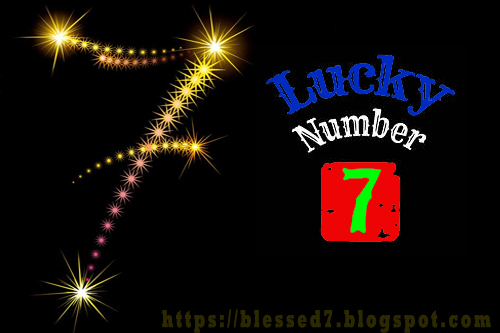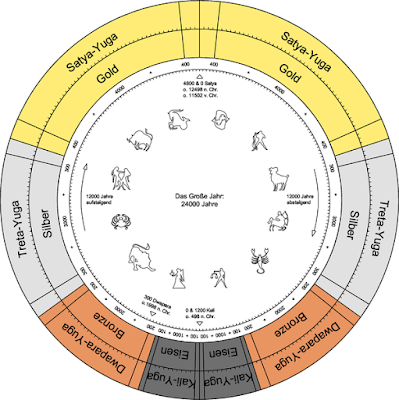
Showing posts with label mortal. Show all posts
Showing posts with label mortal. Show all posts
Thursday, May 29, 2008
Lucky Number 7 - seven is so perfect and powerful that it represents a connection to the universe
From:
Yuga in Hinduism is an epoch or era within a four-age cycle. A complete Yuga starts with the Krita Yuga, via Treta Yuga and Dvapara Yuga into a Kali Yuga.
Yuga: Spiritual -Theosophy Dictionary on Yuga
Yuga (Sanskrit) Age; an age of the world, of which there are four -- satya yuga, treta yuga, dvapara yuga, and kali yuga -- which proceed in succession during the manvantaric cycle. Each yuga is preceded by a period called in the Puranas, sandhya (twilight, transition period, dawn) and followed by another period of like duration often called sandhyansa (a portion of twilight). Each of these transition periods is one-tenth of its yuga. The group of four yugas is first computed by the divine years or years of the gods -- each such year being equal to 360 years of mortal men.
Thus we have, in divine years:
1. Krita or Satya Yuga . . 4,000
Sandhya . . . . . . . . 400
Sandhyansa . . . . . . 400
4,800 or 1,728,000 mortal years
2. Treta Yuga . . . . . . . 3,000
Sandhya . . . . . . . . 300
Sandhyansa . . . . . . . 300
3,600 or 1,296,000 mortal years
3. Dvapara Yuga . . . . . . 2,000
Sandhya . . . . . . . . 200
Sandhyansa . . . . . . . 200
2,400 or 864,000 mortal years
4. Kali yuga . . . . . . . 1,000
Sandhya . . . . . . . . 100
Sandhyansa . . . . . . 100
1,200 or 432,000 mortal years
Total: 12,000 a Mahayuga or 4,320,000 mortal years
Of these four yugas, our present racial period is the kali yuga (black age), often called the Iron Age, said to have commenced at the moment of Krishna's death, usually given as 3102 BC. These yugas do not affect all mankind at the same time, as some races, because of their own special cycles in running, are in one or in another of the yugas, while other races are in a different cycle. This series of 4, 3, 2, 1, with ciphers added or not according to circumstances, are among the sacred computations of archaic esotericism, which shows that all the various kinds of yugas, the small being included within the great, are each governed by the same periodic and regular series -- all of which makes calculation no easy thing.
"All races have their own cycles, which fact causes a great difference. For instance, the Fourth Sub-Race of the Atlanteans was in its Kali-Yug, when destroyed, whereas the Fifth was in its Satya or Krita Yuga. The Aryan Race is now in its Kali Yuga, and will continue to be in it for 427,000 years longer, while various 'family Races,' called the Semitic, Hamitic, etc., are in their own special cycles. The forthcoming 6th Sub Race -- which may begin very soon -- will be in its Satya (golden) age while we reap the fruit of iniquity in our Kali Yuga" (SD 2:147n).
The four yugas refer to any root-race, although indeed a root-race from its individual beginning to its individual ending is about double the length of the great yuga as set forth in the above chart. The racial yugas, however, overlap because each new great race is born at about the middle period of the parent race, although the individual length of any one race is as above stated. Thus it is that by the overlapping of the races, a race and its succeeding race may for a long time be contemporaneous on the face of the globe.
As the four yugas are a reflection in human history of what takes place in the evolution of the earth itself, and also of the planetary chain, the same scheme of yugas applies on larger scales: there exist the four yugas in the time periods of the evolution of a planetary chain, as well as in the general time period of a globe manvantara. These cosmic yugas are very much longer than the racial yugas, but the same general scheme of 4, 3, 2 applies throughout.
"The sacredness of the cycle of 4320, with additional cyphers, lies in the fact that the figures which compose it, taken separately or joined in various combinations, are each and all symbolical of the greatest mysteries in Nature. Indeed, whether one takes the 4 separately, or the 3 by itself, or the two together making 7, or again the three added together and yielding 9, all these numbers have their application in the most sacred and occult things, and record the workings of Nature in her eternally periodical phenomena. They are never erring, perpetually recurring numbers, unveiling, to him who studies the secrets of Nature, a truly divine System, an intelligent plan in Cosmogony, which results in natural cosmic divisions of times, seasons, invisible influences, astronomical phenomena, with their action and reaction on terrestrial and even moral nature; on birth, death, and growth, on health and disease. All these natural events are based and depend upon cyclical processes in the Kosmos itself, producing periodic agencies which, acting from without, affect the Earth and all that lives and breathes on it, from one end to the other of any Manvantara. Causes and effects are esoteric, exoteric, and endexoteric, so to say" (SD 2:73-4).
Labels:
archaic,
astronomical,
cosmic,
cosmogony,
dvapara,
esotericism,
hamitic,
kali,
manvantara,
mortal,
puranas,
racial,
sandhya,
Sanskrit,
satya,
semitic,
Spiritual,
theosophy,
treta,
yugas













